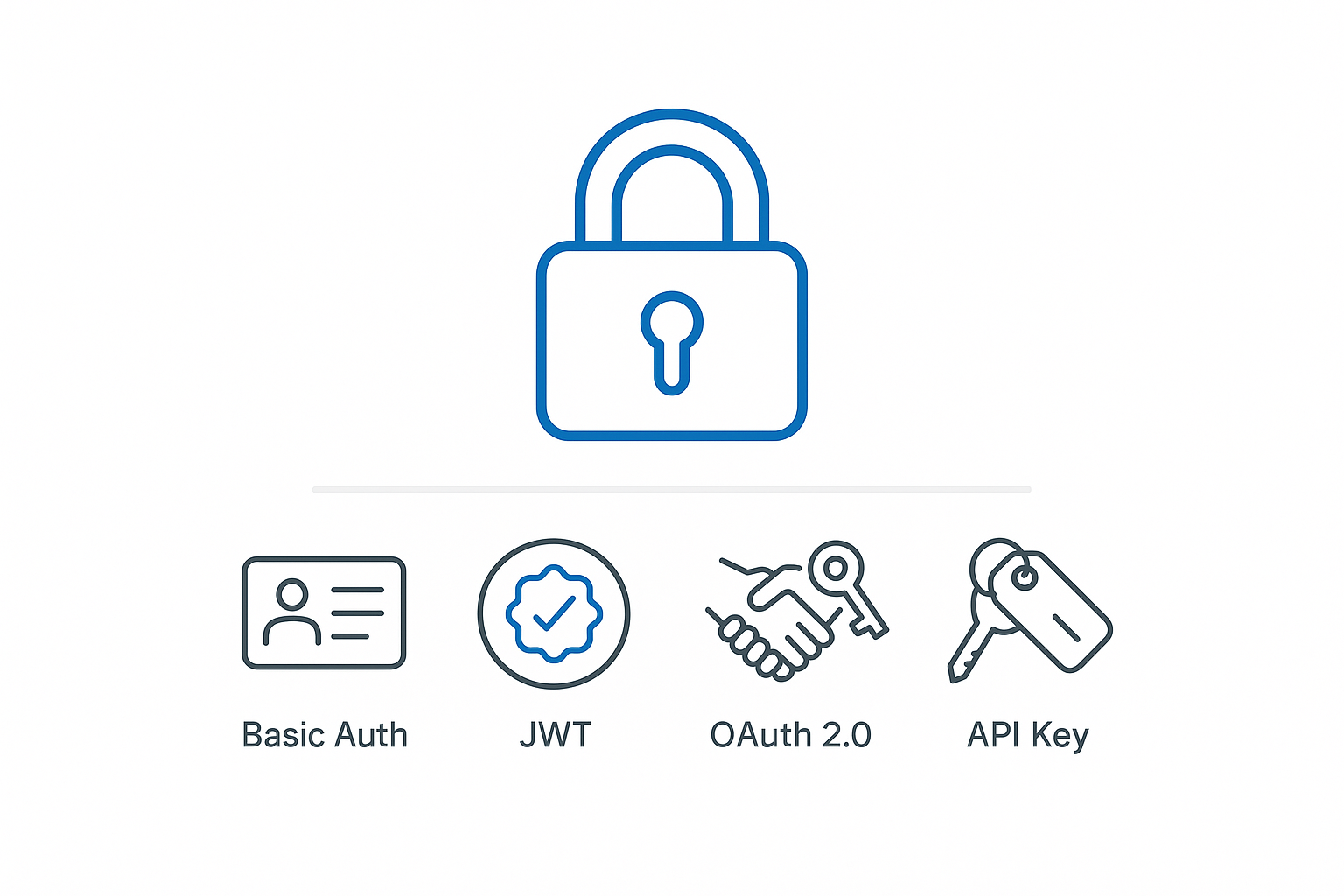
文章探讨了API安全的重要性,并介绍了四种关键的REST API认证方法:基本认证、JWT、OAuth 2.0和API密钥。每种方法都有其适用场景和优缺点。文章还强调了选择合适的认证机制对保护数字资产的关键作用,并建议结合其他安全措施(如授权、速率限制)以实现全面防护。 2025-5-26 14:22:36 Author: securityboulevard.com(查看原文) 阅读量:11 收藏

Securing your API endpoints isn't just good practice—it's essential survival. As cyber threats grow increasingly sophisticated, understanding the authentication mechanisms that protect your digital assets becomes a critical skill for developers and architects alike.
Having built authentication systems that protect millions of user accounts, I've seen firsthand how proper authentication can make or break an application's security posture. Let's dive into the four fundamental REST API authentication methods every developer should master.
Why API Authentication Matters
Before we explore specific methods, let's understand what's at stake. REST APIs serve as the connective tissue of modern applications, enabling everything from mobile apps to IoT devices to access your systems. Without robust authentication:
- Unauthorized users could access sensitive data
- Attackers could manipulate your systems through API calls
- Your infrastructure could be vulnerable to abuse and rate-limiting bypasses
- Compliance requirements (GDPR, HIPAA, etc.) would be impossible to meet
Now, let's unlock the secrets of four essential authentication methods.
🧾 Basic Authentication: The Digital Equivalent of an ID Card
How It Works
Basic Authentication is exactly what it sounds like—basic. It involves transmitting a username and password with each request, encoded in base64 format, typically in the Authorization header:
Authorization: Basic dXNlcm5hbWU6cGFzc3dvcmQ=
The server decodes this string, separates the username and password, and verifies them against stored credentials.
Security Considerations
Here's where things get critical: base64 encoding is not encryption. It's merely encoding that can be easily reversed. This means Basic Authentication must always be used with HTTPS/TLS to prevent credential interception.
When to Use Basic Authentication
- Internal applications within secure networks
- Development environments
- Simple systems where implementation simplicity outweighs security concerns
- When paired with additional security layers (IP restrictions, VPNs)
When to Avoid It
- Public-facing APIs
- Mobile applications (storing credentials securely is challenging)
- High-security environments
- Any scenario where passwords might be intercepted
🔑 Token-Based Authentication (JWT): The Digital Passport
How It Works
JWT (JSON Web Token) authentication addresses many limitations of Basic Authentication by creating a signed token that confirms a user's identity without repeatedly transmitting credentials.
The process works in three steps:
- Authentication: User provides credentials once
- Token Generation: Server validates credentials and issues a signed JWT
- Authorization: Subsequent requests include the JWT instead of credentials
A JWT consists of three parts:
- Header: Contains token type and signing algorithm
- Payload: Contains claims (user ID, permissions, expiration)
- Signature: Verifies the token hasn't been tampered with
Security Advantages
- Credentials are transmitted only once
- Tokens can be scoped to specific permissions
- Tokens have expiration times, limiting damage from theft
- Stateless design improves scalability
Implementation Best Practices
- Set appropriate expiration times (balance security vs. user experience)
- Use refresh tokens for longer sessions
- Store tokens securely (HttpOnly cookies or secure local storage)
- Implement token revocation mechanisms for compromised tokens
- Never store sensitive data in the payload (it's encoded, not encrypted)
When to Use JWT
- Single page applications (SPAs)
- Mobile applications
- Microservices architectures
- When you need stateless authentication
- Cross-domain authentication scenarios
🛡️ OAuth 2.0: The Delegation Framework
How It Works
OAuth 2.0 isn't just an authentication method—it's a framework for authorized access. It enables third-party applications to access resources without exposing user credentials.
The core concept is delegation: users authorize applications to act on their behalf with limited scope.
Key OAuth Flows
Authorization Code Flow:
- User initiates login through third-party app
- User is redirected to authorization server
- User consents to specific permissions (scopes)
- Authorization server returns code to application
- Application exchanges code for access token
- Application uses token to access resources
Client Credentials Flow: Used for server-to-server communication where user consent isn't needed.
Implicit Flow: Simplified flow for browser-based applications (though less recommended now).
Resource Owner Password Credentials Flow: Allows direct credential exchange (used sparingly due to security concerns).
Security Considerations
- Implement proper redirect URI validation
- Use PKCE (Proof Key for Code Exchange) for public clients
- Enforce limited token scopes
- Implement proper token validation
- Set appropriate token lifetimes
When to Use OAuth 2.0
- Third-party integrations
- Social login features
- API ecosystem development
- Granular permission systems
- When you need user consent workflows
📬 API Key Authentication: The Simple Access Pass
How It Works
API keys are long, generated strings provided to developers or services that want to access your API. They're typically included in headers, query parameters, or sometimes in the request body:
Authorization: ApiKey your_api_key_here
X-API-Key: your_api_key_here
Implementation Approaches
- Header-based: Most secure, less exposed
- Query Parameter: Easier for simple integrations but visible in logs
- Mixed Authentication: Combining API keys with other methods for layered security
Security Considerations
- API keys typically don't expire automatically
- They're often shared across an entire application (lack of user-specific context)
- If compromised, they provide full access until revoked
- Key rotation mechanisms are essential
When to Use API Keys
- Public APIs with rate limiting needs
- Developer-focused services
- Internal service-to-service communication
- When simplicity of implementation is paramount
- For services where user context isn't necessary
Choosing the Right Authentication Method
The right authentication approach depends on your specific requirements. Here's a comparative framework:
| Factor | Basic Auth | JWT | OAuth 2.0 | API Keys |
|---|---|---|---|---|
| Implementation Complexity | Low | Medium | High | Low |
| Security Level | Low (without HTTPS) | Medium-High | High | Medium |
| User Experience | Poor (frequent logins) | Good | Good | N/A (backend) |
| Scalability | Poor | Excellent | Good | Good |
| Revocation | Difficult | Challenging | Easy | Moderate |
| Best For | Simple internal apps | Modern web/mobile apps | Delegated access | Service-to-service |
Beyond Authentication: Comprehensive API Security
Authentication is just one layer of API security. For truly robust protection:
- Implement Authorization: Authentication verifies identity; authorization controls what authenticated users can do
- Use Rate Limiting: Prevent abuse with request quantity restrictions
- Validate All Inputs: Prevent injection attacks
- Monitor and Log: Track suspicious activities and maintain audit trails
- Keep Dependencies Updated: Address vulnerabilities in your authentication libraries
- Use HTTPS Everywhere: Encrypt all API traffic
- Consider API Gateways: Centralize authentication and security policies
The Future of API Authentication
The authentication landscape continues to evolve. Watch for these emerging trends:
- Passwordless Authentication: Biometrics, magic links, and other alternatives
- Zero Trust Architecture: Never trust, always verify
- Continuous Authentication: Risk-based assessment beyond the initial authentication
- Decentralized Identity: Blockchain-based solutions that put users in control
Final Thoughts
API authentication isn't just about keeping bad actors out—it's about building trust with partners, customers, and other stakeholders who rely on your services. The method you choose sends a message about how seriously you take security.
In my experience building identity solutions at scale, the most successful approaches balance security with usability. Overly complex security measures often lead to workarounds that create vulnerabilities, while overly simple solutions leave your systems exposed.
Whether you're building a public API for thousands of developers or securing internal microservices, start with a clear understanding of your threat model, user needs, and development resources. The right authentication method will emerge naturally from these requirements.
Remember: in the world of API security, you're only as strong as your weakest gate.
*** This is a Security Bloggers Network syndicated blog from Deepak Gupta | AI & Cybersecurity Innovation Leader | Founder's Journey from Code to Scale authored by Deepak Gupta - Tech Entrepreneur, Cybersecurity Author. Read the original post at: https://guptadeepak.com/unlocking-the-gates-rest-api-authentication-methods-for-modern-security/
如有侵权请联系:admin#unsafe.sh

